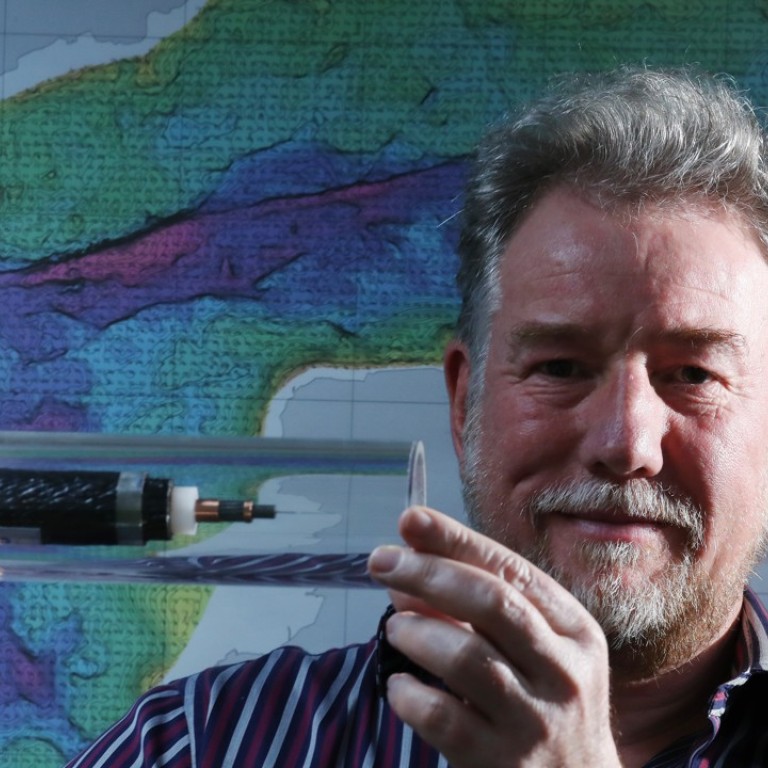
Latest fibre optic technology in Hong Kong to vault the Pacific Ocean
Leap in technology testament to how Hong Kong has developed into a fibre optic telecommunications hub, expert says
By next summer, Hong Kong could be helping internet users stream 80 million high-definition video calls – all at the same time.
This would be thanks to a super high-speed fibre optic cable, which is being built by Google and Facebook, which aims to span the 12,000 kilometres separating Hong Kong and Los Angeles across the Pacific Ocean.
The latest leap in technology was testament to how Hong Kong had developed into a fibre optic telecommunications hub, an industry expert said, as consumers demand faster and more reliable internet.
“Hong Kong is a hub in fibre optics telecommunications. Why do cables land here? It’s well regulated, and it is easier to land bureaucracy wise than in [mainland] China,” said Christopher Welsh, chief executive officer of EGS, an international surveying company based in the city that plans routes for undersea cables.
Roughly the width of a garden hose and buried in the seabed, submarine cables use fibre optic technology to help data transmission from one end to the other at extremely high speed, supporting the world’s internet and communication systems.
Although the majority of cables are owned by telecommunications companies, new players such as Facebook, Microsoft and Google are increasingly investing in their own cables, to provide faster and more reliable services to their growing base of customers.
Hong Kong has 29 submarine cables in service, 21 of them international – the fourth highest in the region, according to data from EGS, which accounts for half of the world’s telecommunications surveying work. Japan tops the charts with more than 50 international cables, Singapore has 25 and Taiwan has 22.
There are no complete sets of data to show how many cables the mainland has.
There are approximately 428 undersea cables around the world, according to TeleGeography, a telecommunications market research consulting firm.
Hong Kong has distinct advantages when it comes to why companies choose to link up to the city, Welsh said.
Similar to how its airport is a hub for travellers worldwide, the city’s geographic proximity to many other advanced locations and economies is why companies – such as banks and finance firms that need quick transactions – prefer shorter routes for the lower latency, or minimal delay.
But the quickest route, may not be the safest route.
“[Companies] want to route their cable around where there has been a lot of volcanic activity, or where cables have broken previously, like between Taiwan and the Philippines,” Welsh said.
“Hong Kong is a generally benign environment for cables.”
On average, there are more than 100 cable faults each year, with two-thirds of them due to accidents caused by fishing vessels and anchors, according to TeleGeography.
“Sometimes politics will determine where a cable goes,” Welsh said.
“Some countries are very difficult places to go and get permission to make a map, as mapping can be sensitive in terms of military perspectives.”
There is only one submarine cable between the mainland and Taiwan, the TeleGeography cable map shows.
“The Taiwan Strait is a channel that has very strong currents, so it’s a hostile environment for cables, and traditionally it’s also a politically sensitive area,” he said.
While there may be plenty of room on the seabed for more submarine cables, Hong Kong faces a shortage of space on land to house the data centres of companies, which the cables are connected to.
IT sector lawmaker Charles Mok said there had been at least 13 new data centres in the industrial area of Tseung Kwan O in the past few years.
Each houses thousands of computers that allow leading companies to store, manage and disseminate data.
On average, each data centre in Tseung Kwan O may be as large as 300,000 sq ft, Mok said.
“The thing that Hong Kong is the worst at is land planning. As the demand for these services surges, the government needs to help make sure that there is enough space for these companies,” he added.
“The more submarine cables there are, the better...But it’s just like electrical wires, what’s the use if they can’t be connected to anything?”

